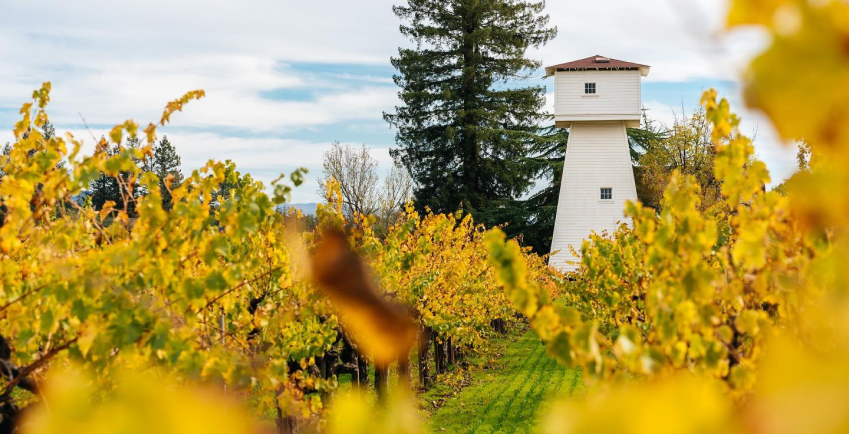In 2000, as the world rang in a new millennium, John Williams welcomed guests to the Fifth Annual Leap Year Party with a rousing Revival theme in the Red Barn, kicking off what was to become a new period of maturation and evolution for the company.
The Barrel Chai construction was completed in 2000; and the winery released it’s first Rutherford, a red wine that embodied the very best of the storied appellation.
Leeds coaxed a few productive years out of the existing Red Barn vineyards and began development of the Galleron Ranch overseeing farming efforts and continuing to implement organic practices and farming without irrigation (dry farming) as new land was acquired. In support of existing organic practices in the vineyards, the winery began to commit additional acreage to diversified farming, adding fruit trees, olives and a half acre of vegetable garden to the Red Barn ranch, earning organic certification for crops and livestock in 2002 with ongoing help from pioneering consultant Amigo Bob Cantisano. Ever evangelists for the cause, the winery enthusiastically supported the Ecological Farming Conference and played host to the first organic growers conference in the Napa Valley in 2002.
In 2004, Frog’s Leap was certified Napa Green, and the work John had helped to spearhead in Rutherford on the River Restoration Project in the late 90s was formally recognized by the California State Legislature. Both the winery and its founder were developing a reputation for thoughtful stewardship and sustainable farming efforts.
Frog’s Leap went solar in 2004, and in 2005, the winery broke ground on a new Vineyard House, which would be the first Leed Certified winery building in California and featured an innovative geothermal heating and cooling system.
Frog’s Leap had been purchasing grapes from the Rossi Family since 1996 and began managing the farming of the property shortly thereafter. In 2007, the winery was offered an opportunity to purchase the Rossi Ranch, which included 50 acres of Rutherford vineyard and two small farmhouses. The Williams family, including Tori Wilder and her young son Owen, moved onto the property that winter. With the acquisition of this prime Rutherford ranch, John’s dream of an Estate winemaking program was within reach.
In 2009, the vineyard team began to remove diseased vines and turn up fallow land — planting back Sauvignon Blanc, Cabernet Sauvignon, and a host of heritage varietals including Morvedre, Carignan, Charbono, Riesling, and Valdigué. The new plantings would ensure fruit for an Estate Cabernet program and lay the foundation for a unique Heritage Blend. Back at the winery, The Fellowship of the Frog was created to offer consumer enthusiasts new ways to order wine and engage with the winery.
John and Tori married in the spring of 2010 and began to update and enhance the land around the historic farmhouse in earnest. In 2012, Rory Williams, John and Julie’s eldest son began working with Frank Leeds on the vineyard team; fittingly participating in the harvest of the winery’s first Estate Cabernet Sauvignon which was released in the Fall of 2014.
The Williams family placed the Rossi Ranch in a conservation easement with the Land Trust of Napa County in the Spring of 2011 and completed a total renovation of the historic home in 2015. Shortly thereafter, work began on construction of a new Farm Center building at the Red Barn property, with dedicated space for farm equipment, a greenhouse and cold storage facilities to support newly planted fruit orchards on both the Rossi and Red Barn properties. Signature events including the Peach Festival and Frogtoberfest take root and the winery began offering educational seated tasting options for guests.
With vineyards reaching full maturity, and Rory spending more time with John in the cellar, the winemaking program at Frog’s Leap was also evolving. Experimentation with a concrete “egg” in 2012 leads to a limited release of Rachel Rossi Reserve Sauvignon Blanc and fuels further investment in concrete tanks, including 10 square 250-gallon tanks to accommodate Zinfandel fermentations.
By 2017, Rory and his wife Molly had taken up residence next door to John and Tori on the Rossi Ranch. In 2020, the release of the 2018 Williams Rossi Cabernet Sauvignon formally recognizes the joining of the two families on the land — and is, not incidentally, the first time in Frog’s Leap history that the Williams family name appears on the front label of the wine they have been producing for more than four decades.
In 2020, following an infamous Leap Year bash with a Burning Man theme the world temporarily shut down. Tori Williams officially joined the Frog’s Leap payroll in July of that year to take over management of the gardens and grounds. Rory Williams is named Vice President of Viticulture and Enology.
At Red Barn, the old double wide trailer that had served for so many years as the Tasting Room is finally removed to make way for an outdoor tasting space which will become known as the Garden Bar. With expanded outdoor space, the entire winery sales team worked to pivot traditional programs and find new ways to keep loyal customers supplied through an unprecedented world health crisis.
Deeply moved by massive local wildfires and drought conditions, and not one to rest on his laurels, John signs on to the Porto Protocols and begins to scrutinize the company’s commitment to sustainability in new ways.
In the fall of 2023, midway through a rather late harvest, Frog’s Leap introduced Flycatcher, a California Appellation red wine blend. The wine is housed in lightweight glass, has no capsule and sports a label that releases in water in hopes of supporting a reusable bottle program in the near future.
PS: if you’re still reading this, then we’ve managed to launch an all-new website. We hope you’ll return to find out what happens next. We can’t wait.

